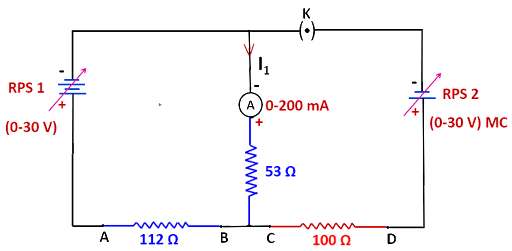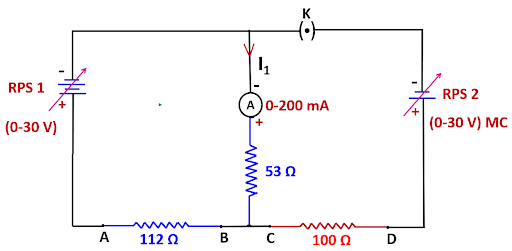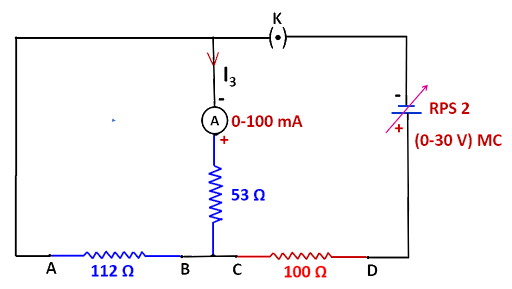
How do you verify the superposition theorem?
Answer
173.1k+ views
Hint:It is crucial to understand what the superposition theorem is before moving on to the issue. A circuit having several voltage and current sources is equal to the sum of simplified circuits employing just one of the sources, according to the superposition theorem.
Complete step by step solution:
Verification of superposition theorem:
The following experiment can be used to practically validate the superposition theorem.
Circuit diagram:

IMAGE: CIRCUIT 1
circuit 2:

circuit 3:

Procedure
1. As seen in the above diagram, connect the circuit.
2. As in circuit 1, set RPS1 and RPS2 to a specific voltage and record the ammeter reading.
3. Set the voltage to the same level by using RPS1 alone to short RPS2, and then record the ammeter reading as in circuit 2.
4. As demonstrated in circuit 3, set the same voltage by shorting RPS1 with RPS2 and recording the ammeter measurement.
5. The superposition theorem must be proven.
Verification
Theoretical values
\[{I_1} = {I_2} + {I_3}\] = 140
Practical values
\[{I_1} = {I_2} + {I_3}\] = 90 mA+ 50 mA = 140 mA
Superposition theorem is therefore practically and theoretically verified.
Note :To apply the superposition theorem to circuit currents and voltages, all of the components must be linear. It should be emphasised that since power is not a linear number, the superposition theorem does not apply to it.
Complete step by step solution:
Verification of superposition theorem:
The following experiment can be used to practically validate the superposition theorem.
Circuit diagram:

IMAGE: CIRCUIT 1
circuit 2:

circuit 3:

Procedure
1. As seen in the above diagram, connect the circuit.
2. As in circuit 1, set RPS1 and RPS2 to a specific voltage and record the ammeter reading.
3. Set the voltage to the same level by using RPS1 alone to short RPS2, and then record the ammeter reading as in circuit 2.
4. As demonstrated in circuit 3, set the same voltage by shorting RPS1 with RPS2 and recording the ammeter measurement.
5. The superposition theorem must be proven.
Verification
Theoretical values
| RPS | Ammeter Reading | ||
| 1 | 2 | ||
| Circuit 1 | 20 V | 10 V | \[{I_1} = 140\] |
| Circuit 2 | 20 V | 0 V | \[{I_2} = 90\] |
| Circuit 3 | 0 V | 10 V | \[{I_3} = 50\] |
\[{I_1} = {I_2} + {I_3}\] = 140
Practical values
| RPS | Ammeter reading | ||
| 1 | 2 | ||
| Circuit 1 | 20 V | 10 V | \[{I_1} = 140\] |
| Circuit 2 | 20 V | 0 V | \[{I_2} = 90\] |
| Circuit 3 | 0 V | 10 V | \[{I_3} = 50\] |
\[{I_1} = {I_2} + {I_3}\] = 90 mA+ 50 mA = 140 mA
Superposition theorem is therefore practically and theoretically verified.
Note :To apply the superposition theorem to circuit currents and voltages, all of the components must be linear. It should be emphasised that since power is not a linear number, the superposition theorem does not apply to it.
Recently Updated Pages
JEE Main Mock Test 2025-26: Chapter-Wise Practice Papers

JEE Main Electromagnetic Waves Mock Test 2025-26 | Free Practice Online

JEE Main 2025-26 Electronic Devices Mock Test: Free Practice Online

JEE Main Mock Test 2025-26: Current Electricity Practice Online

JEE Main 2025-26 Electrostatics Mock Test – Free Practice Online

JEE Main 2025-26 Units and Measurements Mock Test Online

Trending doubts
JEE Main 2025 Session 2: Application Form (Out), Exam Dates (Released), Eligibility, & More

Displacement-Time Graph and Velocity-Time Graph for JEE

Uniform Acceleration

Electric field due to uniformly charged sphere class 12 physics JEE_Main

JEE Main 2025: Derivation of Equation of Trajectory in Physics

Atomic Structure - Electrons, Protons, Neutrons and Atomic Models

Other Pages
JEE Advanced Marks vs Ranks 2025: Understanding Category-wise Qualifying Marks and Previous Year Cut-offs

Learn About Angle Of Deviation In Prism: JEE Main Physics 2025

Enthalpy of Combustion with Examples for JEE

Instantaneous Velocity - Formula based Examples for JEE

JEE Advanced Weightage 2025 Chapter-Wise for Physics, Maths and Chemistry

Essential Derivations for CBSE Class 12 Physics: Stepwise & PDF Solutions




